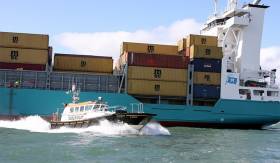Displaying items by tag: Timber trading cargoships
#ShippingReview - Jehan Ashmore reviews the shipping scene from among the following stories of recent weeks.
‘Safe and sustainable’ marine transport and ‘delivery of emergency management services’ have been made a high level goal in the Department of Transport’s Statement of Strategy 2016-2019
UK shipbuilder Cammell Laird saw profits and sales fall last year – but the shipyard on Merseyside where Irish Ferries flagship Ulysses (currently drydocking) remains upbeat to win more contracts.
Ardmore Shipping Corporation the product/chemical tanker operator which has its Principal Operating Office in Cork City has made several appointments to overseas offices.
To prepare for a hard Brexit, Enterprise Ireland is advising firms here amid growing signs the British government may opt to quit the single market in order to regain full control over immigration.
County councillors from all main parties of Dún Laoghaire-Rathdown expressed concern at potential financial liabilities in the transfer of Dún Laoghaire Harbour.
In recent weeks at Rosslare Europort dredger Sospan Dau carried out work within the harbour to remove spoil offshore, benefitting not just ferries but cruiseships and timber trading cargoships.
Arklow Castle was launched in the Netherlands as the third ‘C’ class newbuild of a 10-ship order from ASL. The 5,054dwt cargoship slid into the canal at Ferus Smit shipyard in Westerbroek.
Dredging Works Completed Not Just for Ferries of Rosslare Europort
#Dredging - In recent weeks at Rosslare Europort a dredging programme was conducted within the harbour to remove spoil offshore, writes Jehan Ashmore.
Dredging operations were carried out by Sospan Dau and assistance from tug Trojan. The resultant spoil was taken offshore and near the Lucifer Bouy.
The works are to maintain sufficient depths at the ferryport's four (one not used) linkspans located on two piers. Asides the ferry industry, the Wexford port has timber trading cargoships and the first cruiseship, Braemar in two decades called last season.
In further efforts to attract business the Irish Rail operated port are to waive fees for cruiseships calling during this year's season and up to 2019.
Ferries sail to Wales and France and in the high season there are four services using three routes. They are operated by just two operators, Irish Ferries and Stena Line. Celtic Link Ferries year-round service to Cherbourg and route ship Celtic Horizon (Stena Horizon docked this afternoon in Rosslare) was acquired almost three years ago (March 2014) by the giant Swedish-owned operator.
At the height of Storm Barbara, the second of this year’s storms, Afloat noted Sospan Dau, the Boskalis operated trailing suction hopper dredger take shelter at Wicklow Port.
This saw the ship berth alongside the South Pier. It is along this breakwater during the Round Ireland Yacht Race is where crowds gather to watch the start of the biennial held event. The last such event was held last year.

























































